automatic transmission fluid CHEVROLET CAMARO 1994 4.G Owners Manual
[x] Cancel search | Manufacturer: CHEVROLET, Model Year: 1994, Model line: CAMARO, Model: CHEVROLET CAMARO 1994 4.GPages: 292, PDF Size: 15.35 MB
Page 148 of 292
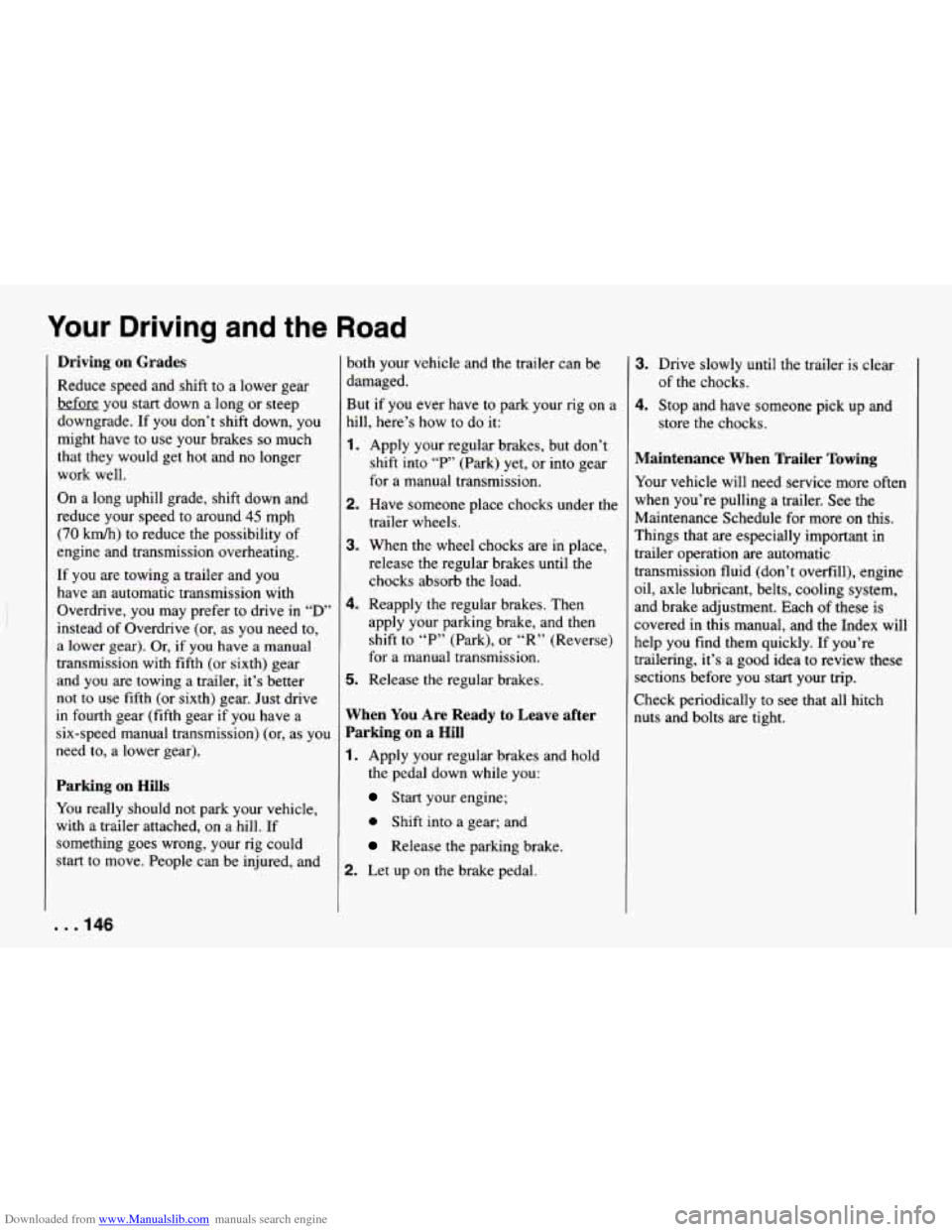
Downloaded from www.Manualslib.com manuals search engine Your Driving and the Road
Driving on Grades
Reduce speed and shift to a lower gear
before you start down a long or steep
downgrade. If you don’t shift down, you
might have to use your brakes
so much
that they would get hot and no longer
work well.
On a long uphill grade, shift down and
reduce your speed to around
45 mph
(70 kmh) to reduce the possibility of
engine and transmission overheating.
If you are towing a trailer and you
have an automatic transmission with
Overdrive, you may prefer to drive
in “D’
instead of Overdrive (or, as you need to,
a lower gear). Or,
if you have a manual
transmission with fifth (or sixth) gear
and you are towing a trailer, it’s better
not to use fifth (or sixth) gear. Just drive
in fourth gear (fifth gear if you have a
six-speed manual transmission) (or, as you
need to, a lower gear).
Parking on Hills
You really should not park your vehicle,
with a trailer attached, on a
hill. If
something goes wrong, your rig could
start to move. People can be injured, and both your vehicle and the trailer can be
damaged.
But if you
ever have to park your
rig on a
hill, here’s how to do it:
1. Apply your regular brakes, but don’t
shift into
“P’ (Park) yet, or into gear
for a manual transmission.
2. Have someone place chocks under the
3. When the wheel chocks are in place,
release the regular brakes until the
chocks absorb the load.
trailer wheels.
4. Reapply the
regular brakes. Then
apply your parking brake, and then
shift to
“P” (Park), or “R” (Reverse)
for a manual transmission.
5. Release the regular brakes.
When You Are Ready to Leave after
Parking on a Hill
1. Apply your regular brakes and hold
the pedal down while you:
Start your engine;
0 Shift into a gear; and
Release the parking brake.
2. Let up on the brake pedal.
3. Drive slowly until the trailer is clear
4. Stop ahd have someone pick up and
of the
chocks.
store the chocks.
Maintenance When Trailer Towing
Your vehicle will need service more often
when you’re pulling a trailer. See the
Maintenance Schedule for more on this.
Things that are especially important in
trailer operation are automatic
transmission fluid (don’t overfill), engine
oil, axle lubricant, belts, cooling system,
and brake adjustment. Each of these is
covered in this manual, and
the Index will
help you find them quickly. If you’re
trailering, it’s a good idea to review these
sections before you start your
trip.
Check periodically to see that all hitch
nuts and bolts are tight.
. . ,146
Page 181 of 292
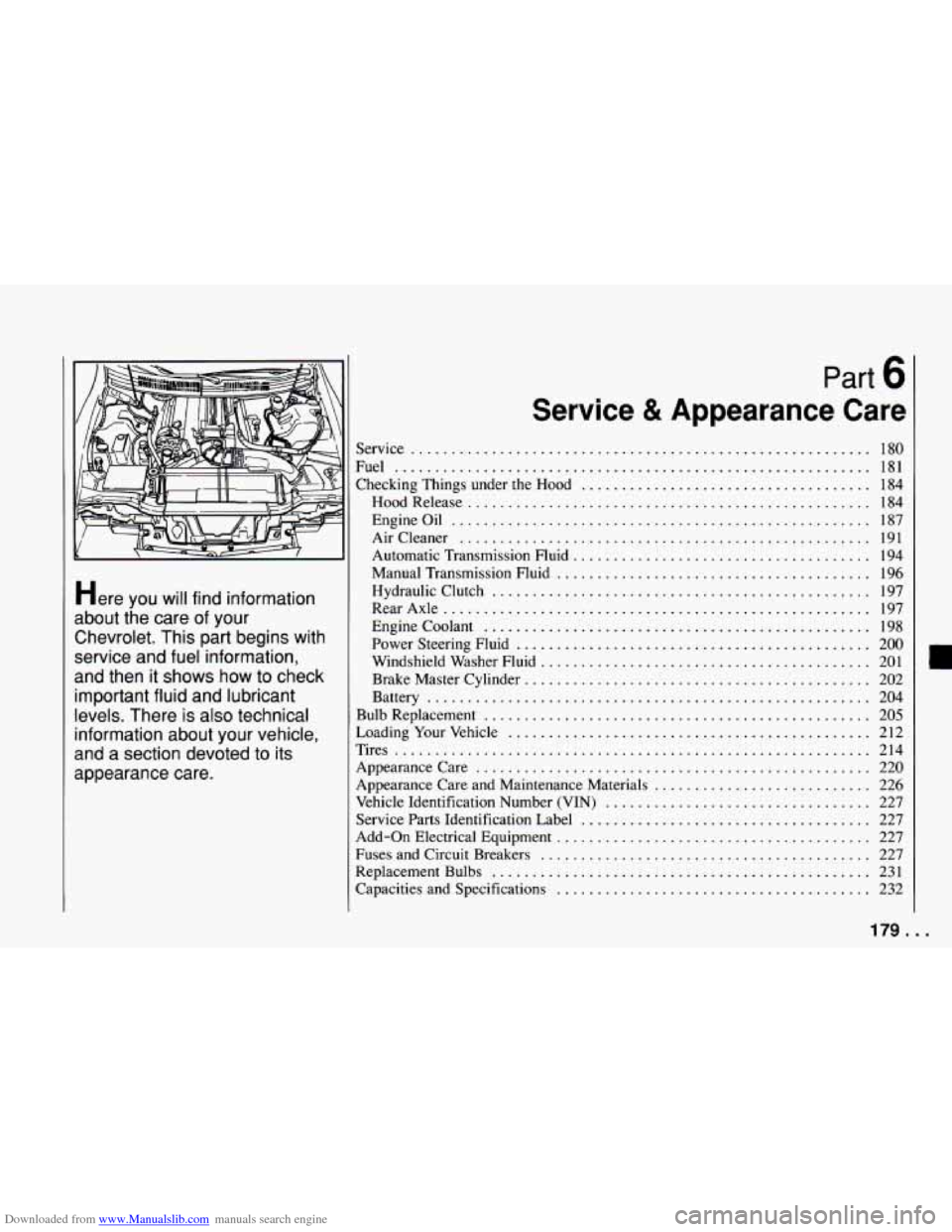
Downloaded from www.Manualslib.com manuals search engine Here you will find information
about the care of your
Chevrolet
. This part begins with
service and fuel information.
and then
it shows how to check
important fluid and lubricant
levels
. There is also technical
information about your vehicle.
and a section devoted to its
appearance care
.
Part 0
Service & Appearance Care
Service .........................................................
Fuel ...........................................................
Checking Things under the Hood ....................................
HoodRelease ..................................................
EngineOil ....................................................
Aircleaner ...................................................
Automatic Transmission Fluid .....................................
Manual Transmission Fluid .......................................
Hydraulic Clutch ...............................................
RearAxle .....................................................
Enginecoolant ................................................
Power Steering Fluid ............................................
Windshield Washer Fluid .........................................
Brake Master Cylinder ...........................................
Battery .......................................................
Bulb Replacement ................................................
LoadingYourVehicle .............................................
Tires ...........................................................
Appearancecare .................................................
Appearance Care and Maintenance Materials ...........................
Vehicle Identification Number (VIN) .................................
Service Parts Identification Label ....................................
Add-on Electrical Equipment .......................................
Fuses and Circuit Breakers .........................................
Replacement Bulbs ...............................................
Capacities and Specifications .......................................
180
181
184
184
187 191
194
196
197
197
198
200
201
202
204
205
212
214
220
226
227
227
227
227
231
232
179 ...
Page 187 of 292
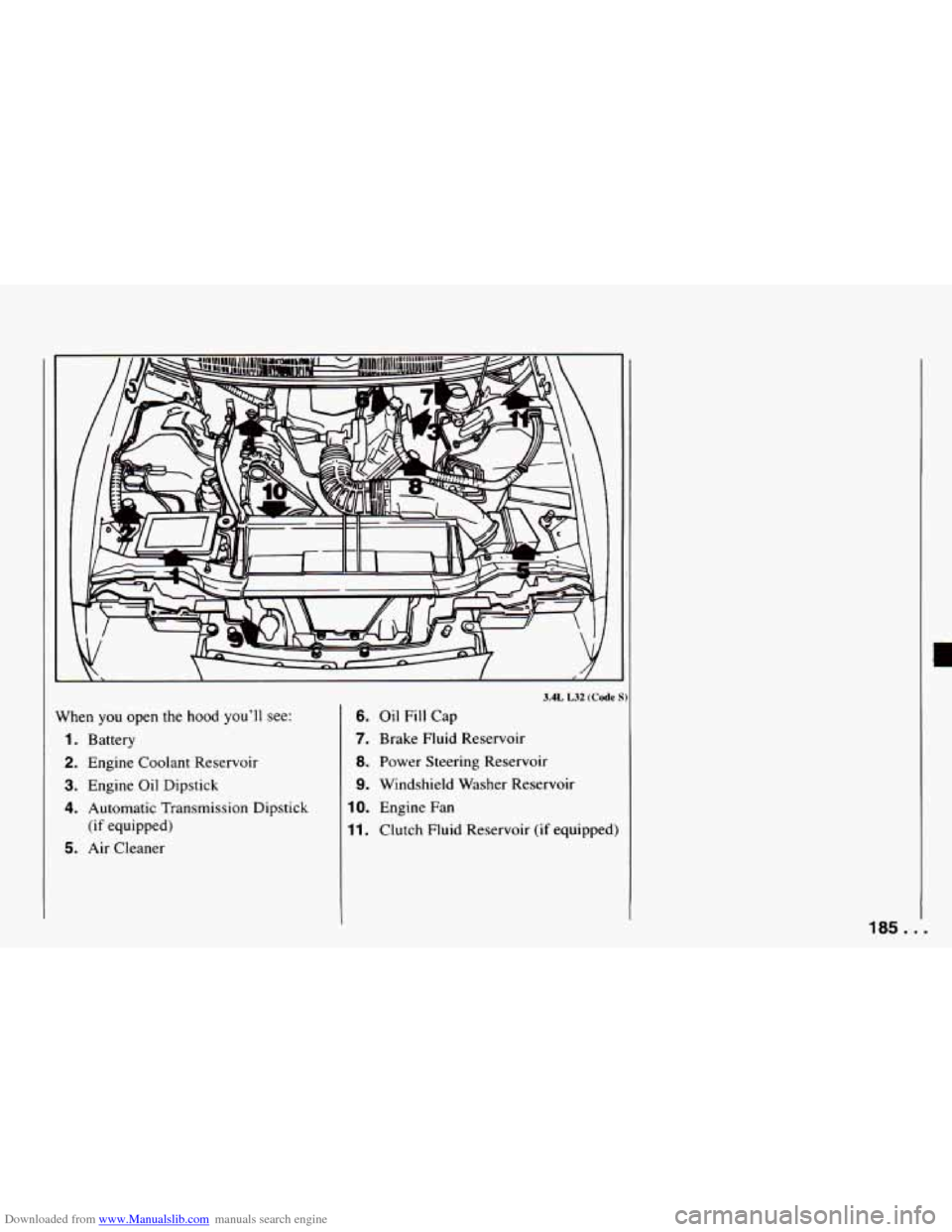
Downloaded from www.Manualslib.com manuals search engine When you open the hood you'll see:
1. Battery
2. Engine Coolant Reservoir
3. Engine Oil Dipstick
4. Automatic Transmission Dipstick
5. Air Cleaner (if equipped)
3.4L L32 (Code S
6. Oil Fill Cap
7. Brake Fluid Reservoir
8. Power Steering Reservoir
9. Windshield Washer Reservoir
10. Engine Fan
11. Clutch Fluid Reservoir (if equipped)
L
185 ...
Page 188 of 292
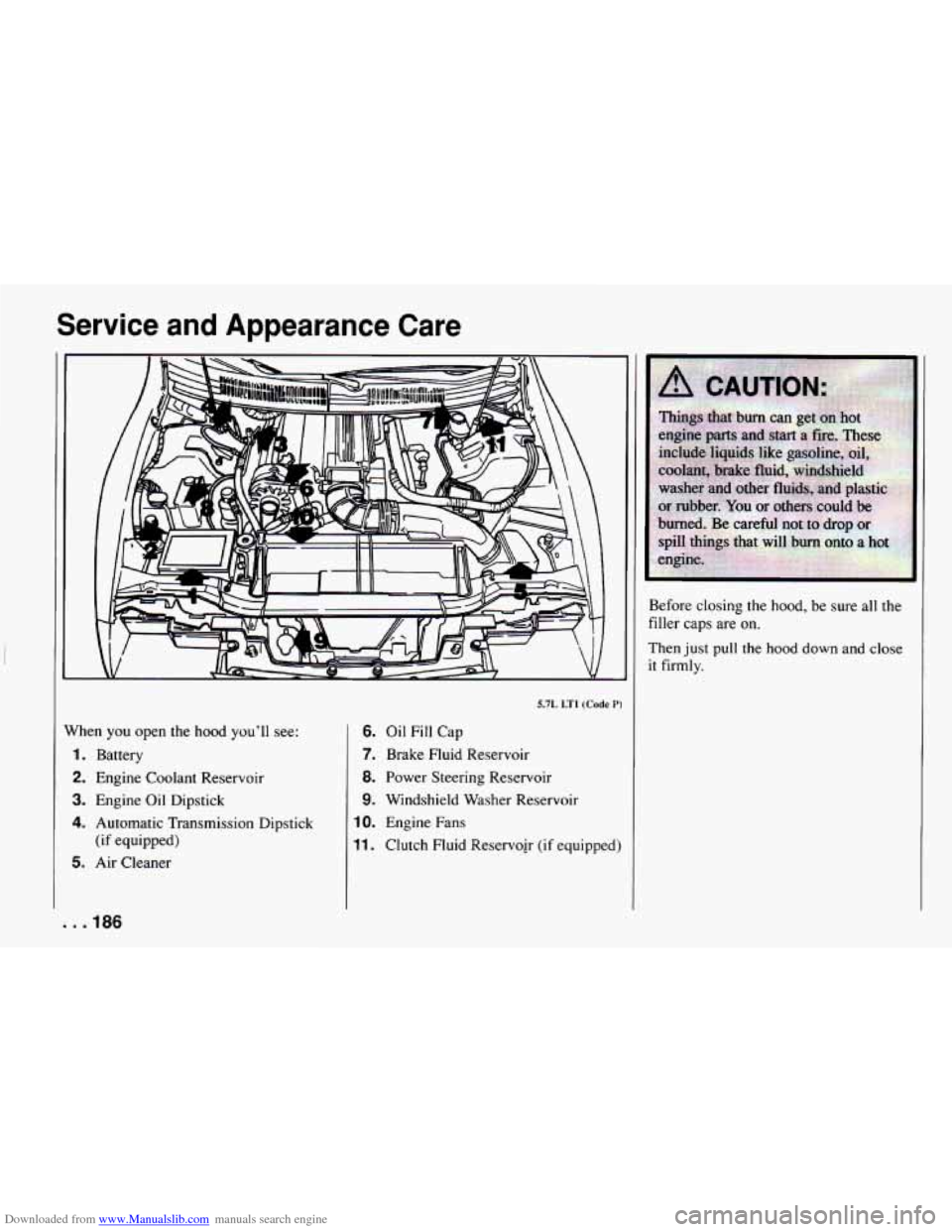
Downloaded from www.Manualslib.com manuals search engine Service and Appearance Care
5.7L LT1 (Code P)
Vhen you open the hood you’ll see:
1. Battery
2. Engine Coolant Reservoir
3. Engine Oil Dipstick
4. Automatic Transmission Dipstick
5. Air Cleaner
(if equipped)
6. Oil Fill Cap
7. Brake Fluid Reservoir
8. Power Steering Reservoir
9. Windshield Washer Reservoir
10. Engine Fans
11. Clutch Fluid Reservoir (if equipped) Before
closing the hood, be sure all the
filler
caps are on.
Then just pull the hood down and close
it firmly.
. . .186
Page 196 of 292
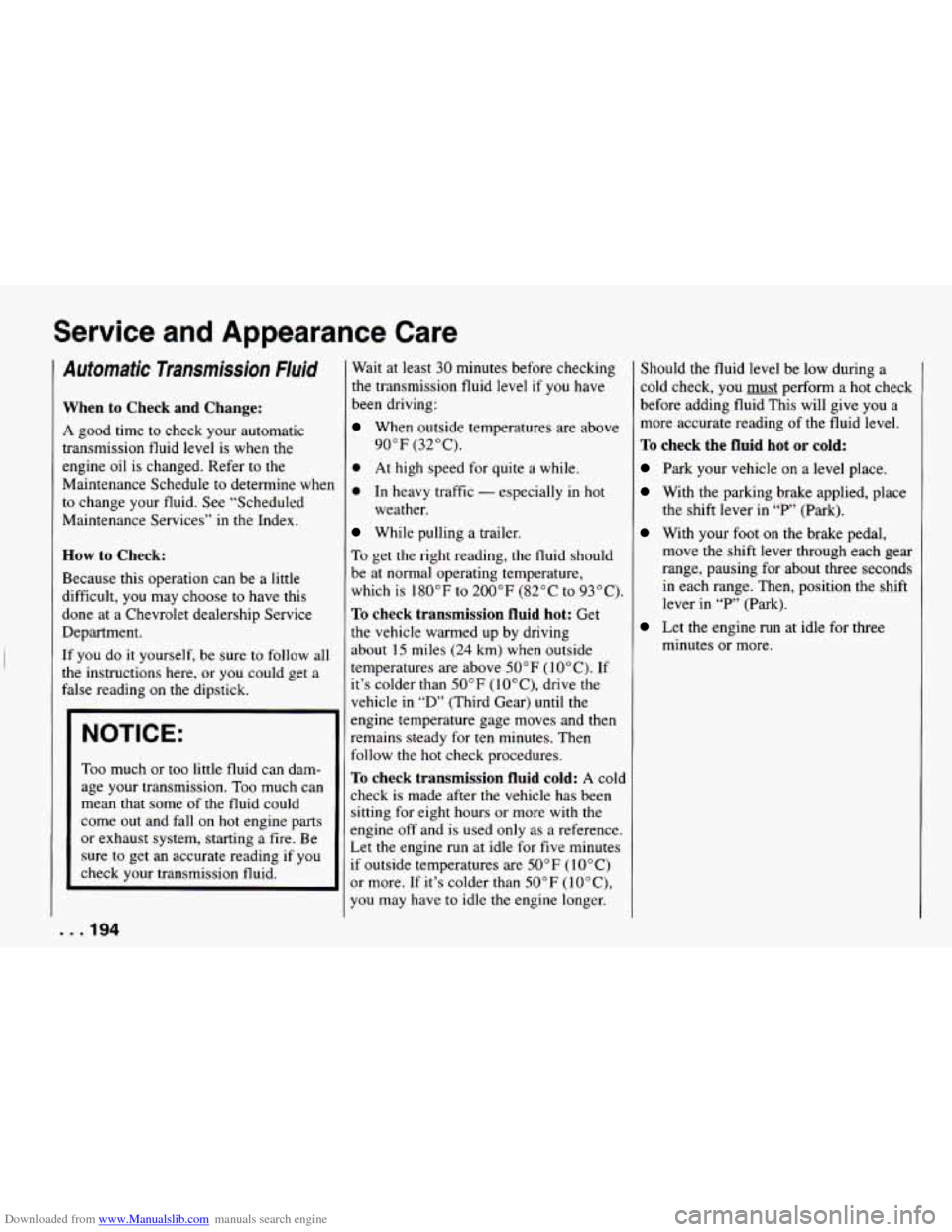
Downloaded from www.Manualslib.com manuals search engine Service and Appearance Care
Automatic Transmission FIuid
When to Check and Change:
A good time to check your automatic
transmission fluid level is when the
engine oil is changed. Refer to the
Maintenance Schedule to determine when
to change your fluid. See “Scheduled
Maintenance Services” in the Index.
How to Check:
Because this operation can be a little
difficult, you may choose to have this
done at a Chevrolet dealership Service
Department.
If
you do it yourself, be sure to follow all
the instructions here, or
you could get a
false reading on the dipstick.
NOTICE:
Too much or too little fluid can dam-
age your transmission.
Too much can
mean that some of the fluid could
come out and fall on hot engine parts
or exhaust system, starting a fire. Be
sure to get an accurate reading if you
check your transmission fluid.
. . ,194
Wait at least 30 minutes before checking
the transmission fluid level
if you have
been driving:
When outside temperatures are above
90°F (32°C).
0 At high speed for quite a while.
0 In heavy traffic - especially in hot
weather.
While pulling a trailer.
To get the right reading, the fluid should
be at normal operating temperature,
which is 180°F to
200°F (82°C to 93°C).
To check transmission fluid hot: Get
the vehicle warmed up
by driving
about
15 miles (24 km) when outside
temperatures are above 50°F (10°C). If
it’s colder than
50°F (lO”C), drive the
vehicle
in “D” (Third Gear) until the
engine temperature gage moves and then
remains steady for ten minutes. Then
follow the hot check procedures.
To check transmission fluid cold: A cold
check is made after the vehicle has been
sitting for eight hours or more with the
engine off and is used only as a reference.
Let the engine run at idle for five minutes
if outside temperatures are 50°F
( 10°C)
or more. If it’s colder than 50°F (lO”C),
you may have to idle the engine longer. Should the fluid level
be
low during a
cold check, you must perform a hot check
before adding fluid This will give you a
more accurate reading
of the fluid level.
To check the fluid hot or cold:
Park your vehicle on a level place.
With the parking brake applied, place
With your foot on the brake pedal,
the shift lever
in
“P’ (Park).
move the shift lever through each gear
range, pausing for about three seconds in each range. Then, position the shift
lever in
“F’” (Park).
minutes or more.
Let the engine run at idle for three
Page 198 of 292
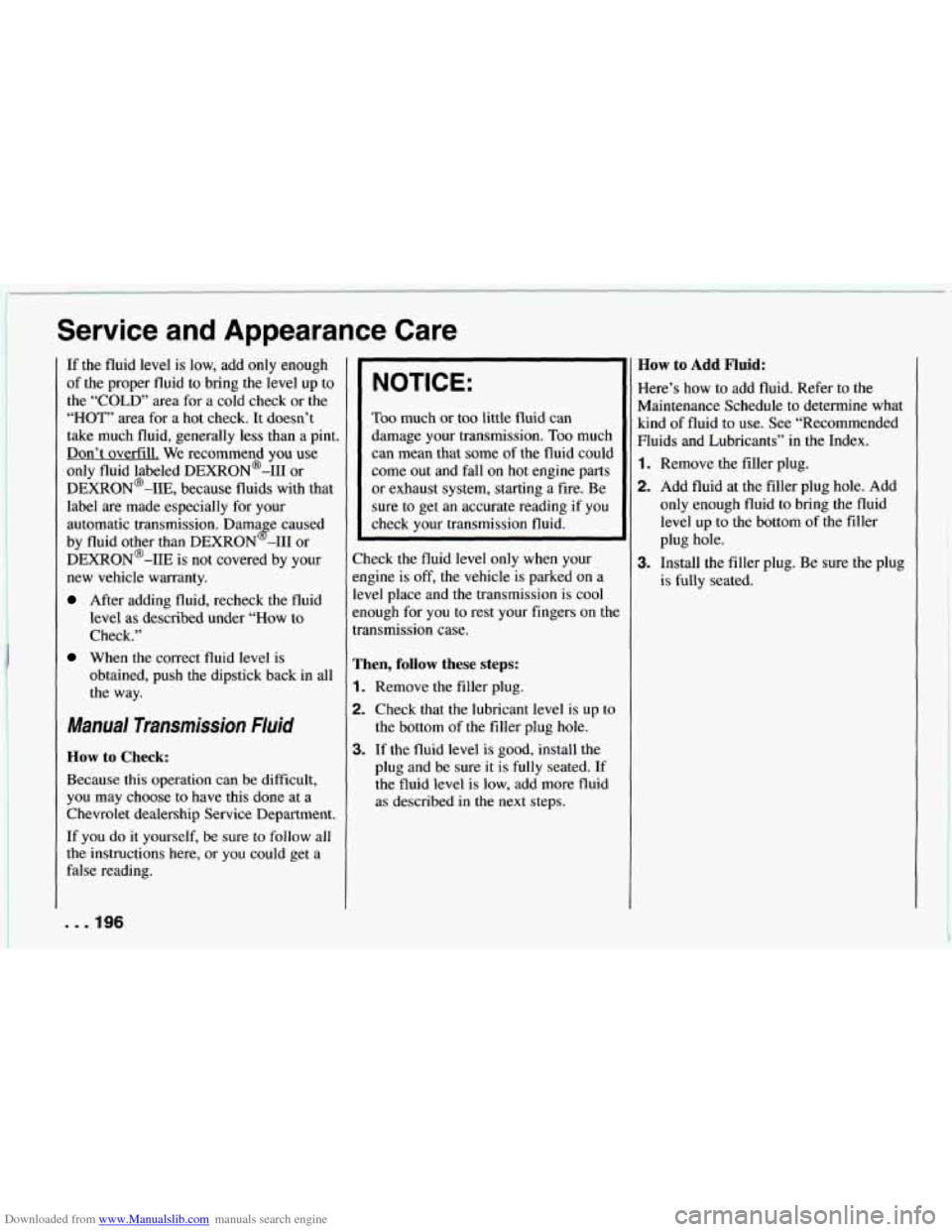
Downloaded from www.Manualslib.com manuals search engine Service and Appearance Care
If the fluid level is low, add only enough
of the proper fluid to bring the level up to
the “COLD’ area for a cold check or the
“HOT” area for a hot check. It doesn’t
take much fluid, generally less than a pint.
Don’t overfill. We recommend you
use
only fluid labeled DEXRON@-III or
DEXRON@-IIE, because
fluids with that
label are made especially for your
automatic transmission. Dama e caused
by fluid other than DEXRON
-111 or
DEXRON@-IIE is not covered by your
new vehicle warranty.
After adding fluid, recheck the fluid
level as described under
“How to
Check.”
obtained, push the dipstick back in all
the way.
D
When the correct fluid level is
Manual Transmission Fluid
How to Check:
Because this operation can be difficult,
you may choose to have this done at a
Chevrolet dealership Service Department.
If you do it yourself, be sure to follow all
the instructions here, or
you could get a
false reading.
Too much or too little fluid can
damage your transmission.
Too much
can mean that some of the fluid could
come out and fall on hot engine parts
or exhaust system, starting a fire. Be
sure to get an accurate reading if you
check your transmission fluid.
Check the fluid level only when your
engine is off, the vehicle is parked on a
level place and the transmission is cool
enough for you to rest your fingers on
the
transmission case.
Then, follow these steps:
1. Remove the filler plug.
2. Check that the lubricant level is up to
the bottom of
the filler plug hole.
3. If the fluid level is good, install the
plug and be sure it
is fully seated. If
the fluid level is low, add more fluid
as described in the next steps.
How to Add Fluid:
Here’s how to add fluid. Refer to the
Maintenance Schedule to determine what
kind
of fluid to use. See “Recommended
Fluids and Lubricants” in the Index.
1. Remove the filler plug.
2. Add fluid at the filler plug hole. Add
only enough fluid to bring the fluid
level up to the bottom of
the filler
plug hole.
3. Install the filler plug. Be sure the plug
is fully seated.
,. 196
Page 236 of 292
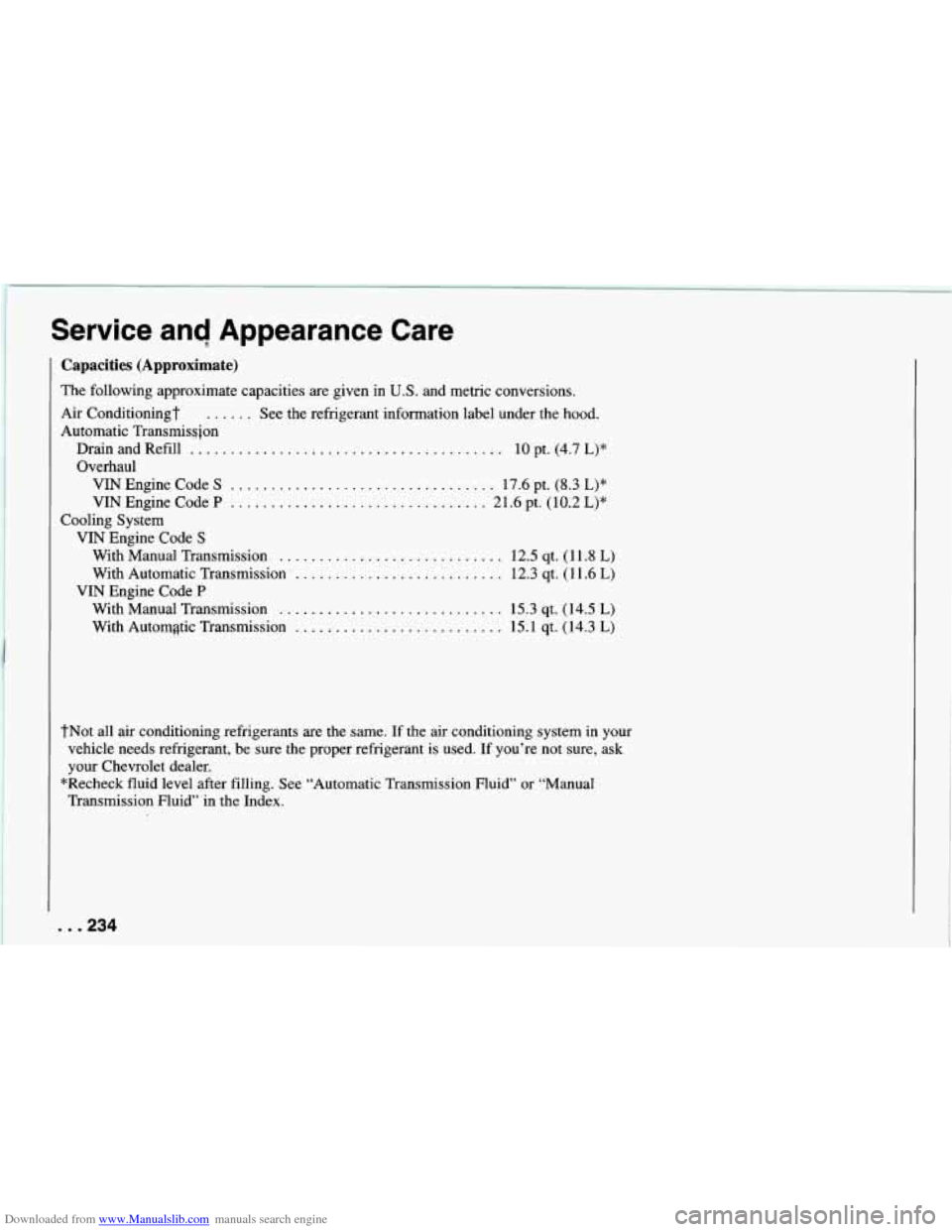
Downloaded from www.Manualslib.com manuals search engine Service and Appearance Care
Capacities (Approximate)
The following approximate capacities are given in U.S. and metric conversions.
Air Conditioningt
...... See the refrigerant information label under the hood.
Automatic Transmissjon Drain and Refill
....................................... 10 pt. (4.7 L)*
VIN Engine Code S ................................. 17.6 pt. (8.3 L)*
VIN Engine Code P ................................ 21.6 pt. (10.2 L)*
With Manual Transmission
............................ 12.5 qt. (1 1.8 L)
With Automatic Transmission .......................... 12.3 qt. (1 1.6 L)
With Manual Transmission ............................ 15.3 qt. (14.5 L)
With Autoqtic Transmission .......................... 15.1 qt. (14.3 L)
Overhaul
Cooling System VIN Engine Code
S
VIN Engine Code P
tNot all air conditioning refrigerants are the same. If the air conditioning system in your
vehicle needs refrigerant, be sure the proper refrigerant is used.
If you’re not sure, ask
your Chevrolet dealer.
Transmission Fluid” in the Index.
*Recheck
fluid level after filling. See “Automatic Transmission Fluid” or “Manual
.. .234
Page 237 of 292
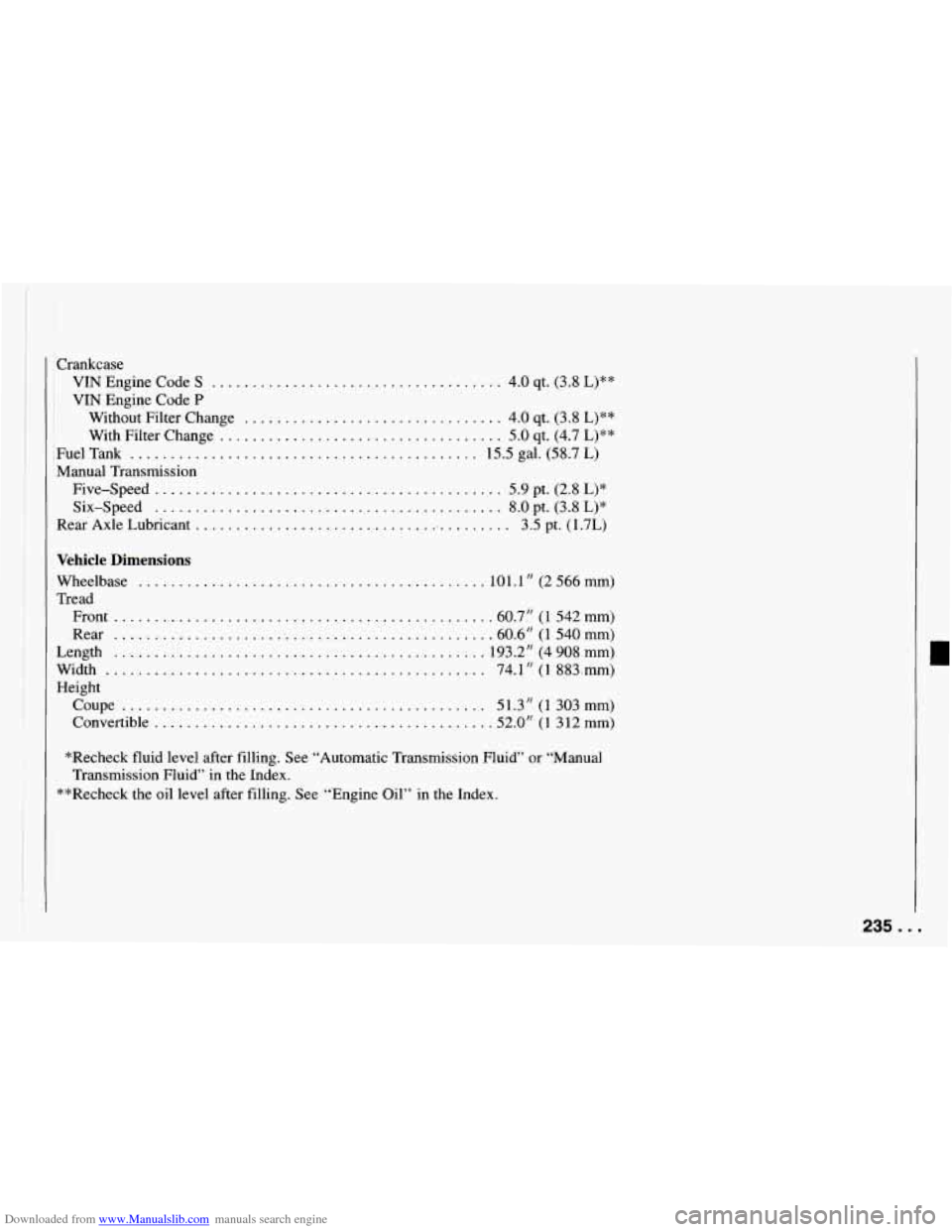
Downloaded from www.Manualslib.com manuals search engine Crankcase
VIN Engine Code S .................................... 4.0 qt. (3.8 L)**
Without Filter Change
................................ 4.0 qt. (3.8 L)**
With Filter Change
................................... 5.0 qt. (4.7 L)**
Fuel Tank ........................................... 15.5 gal. (58.7 L)
Five-Speed
........................................... 5.9 pt. (2.8 L)*
Six-Speed
........................................... 8.0 pt. (3.8 L)*
Rear Axle Lubricant
........................................ 3.5 pt. (1.7L)
VIN Engine Code P
Manual Transmission
Vehicle Dimensions
Tread Wheelbase
........................................... 101.1 ‘I (2 566 mm)
Front
.............................................. .60.7 ‘I (1 542 mm)
Length
.............................................. 193.2” (4 908 mm)
Coupe
............................................. 5 1.3“ (1 303 mm)
Convertible
......................................... .52.0” (1 3 12 mm)
Rear ............................................... .60.6“ (1 540 mm)
Width
............................................... 74.1 ‘I (1 883.mm)
Height
*Recheck fluid level after filling. See “Automatic Transmission Fluid” or “Manual Transmission Fluid” in the Index.
**Recheck the oil level after filling. See “Engine Oil” in the Index.
235. ..
Page 247 of 292
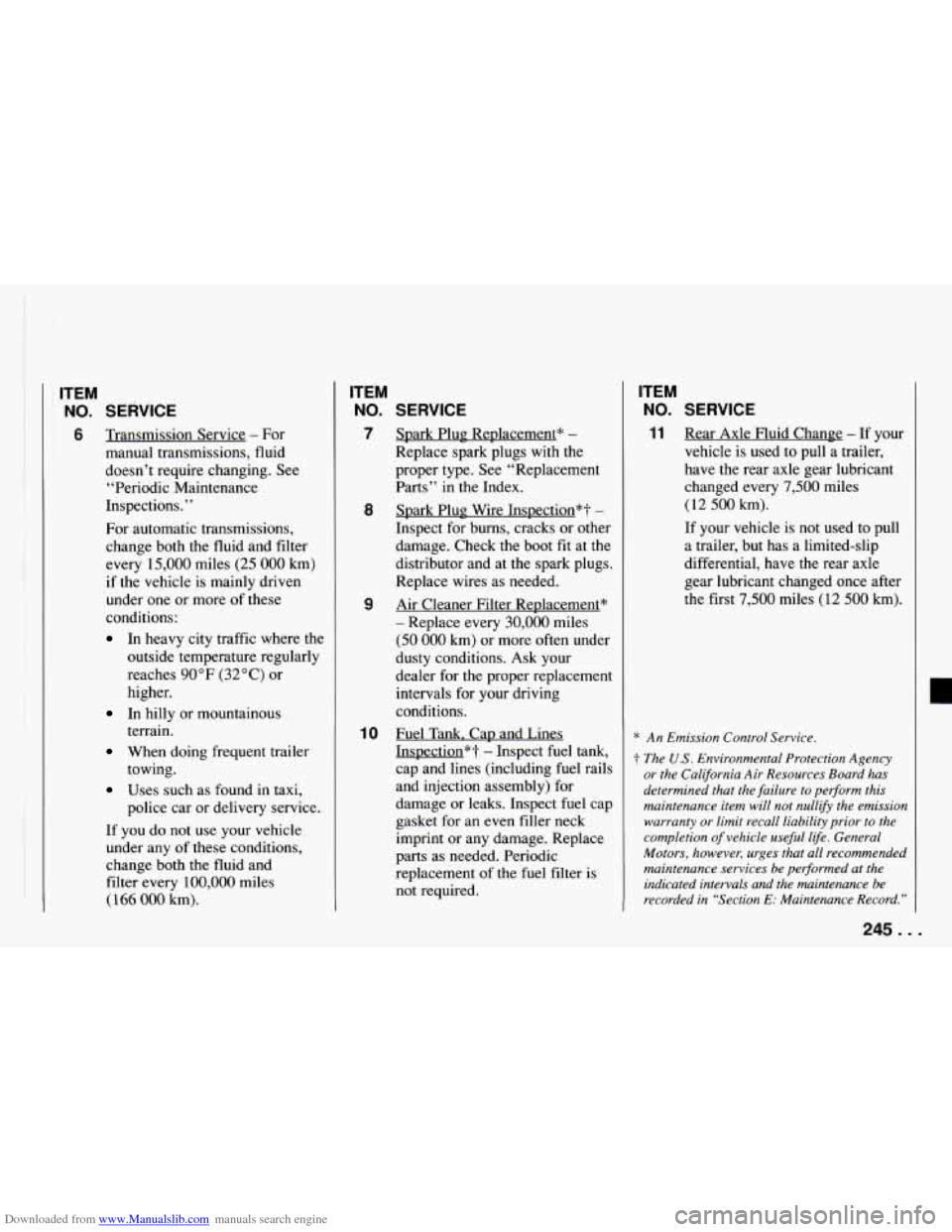
Downloaded from www.Manualslib.com manuals search engine ITEM
NO. SERVICE
6 Transmission Service - For
manual transmissions, fluid
doesn’t require changing. See “Periodic Maintenance
Inspections.”
For automatic transmissions, change both
the fluid and filter
every 15,000 miles (25
000 km)
if the vehicle is mainly driven
under one or more of these
conditions:
In heavy city traffic where the
outside temperature regularly
reaches
90°F (32°C) or
higher.
In hilly or mountainous
terrain.
When doing frequent trailer
towing.
Uses such as found in taxi,
police car or delivery service.
If
you do not use your vehicle
under any
of these conditions,
change both
the fluid and
filter every
100,000 miles
(166 000 km).
ITEM
NO.
7
8
9
10
SERVICE
Spark Plug Replacement* -
Replace spark plugs with the
proper type. See “Replacement
Parts” in the Index.
Spark Plug Wire Inspection*?
-
Inspect for burns, cracks or other
damage. Check the boot
fit at the
distributor and at the spark plugs.
Replace wires as needed.
Air Cleaner Filter Replacement*
- Replace every 30,000 miles
(50 000 km) or more often under
dusty conditions. Ask your
dealer for the proper replacement
intervals for your driving
conditions.
Fuel Tank. Cap and Lines
Inspection”?
- Inspect fuel tank,
cap and lines (including fuel rails
and injection assembly) for
damage or leaks. Inspect fuel cap
gasket for an even filler neck
imprint or any damage. Replace
parts as needed. Periodic
replacement of the fuel filter is
not required.
ITEM
NO. SERVICE
11 Rear Axle Fluid Change - If your
vehicle is used to pull
a trailer,
have the rear axle gear lubricant
changed every
7,500 miles
(12
500 km).
If your vehicle is not used
to pull
a trailer, but has a limited-slip
differential, have the rear axle
gear lubricant changed once after
the first
7,500 miles (12 500 km).
* An Emission Control Service.
t The US. Environmental Protection Agency
or the California Air Resources Board has
determined that the failure to pegorm this
maintenance item will not nullify the emission
warranty or limit recall liability prior to the
completion of vehicle useful life. General
Motors, however, urges that all recommended
maintenance services be performed at the
indicated intervals and the maintenance be
recorded in “Section
E: Maintenance Record.”
245.. .
Page 253 of 292
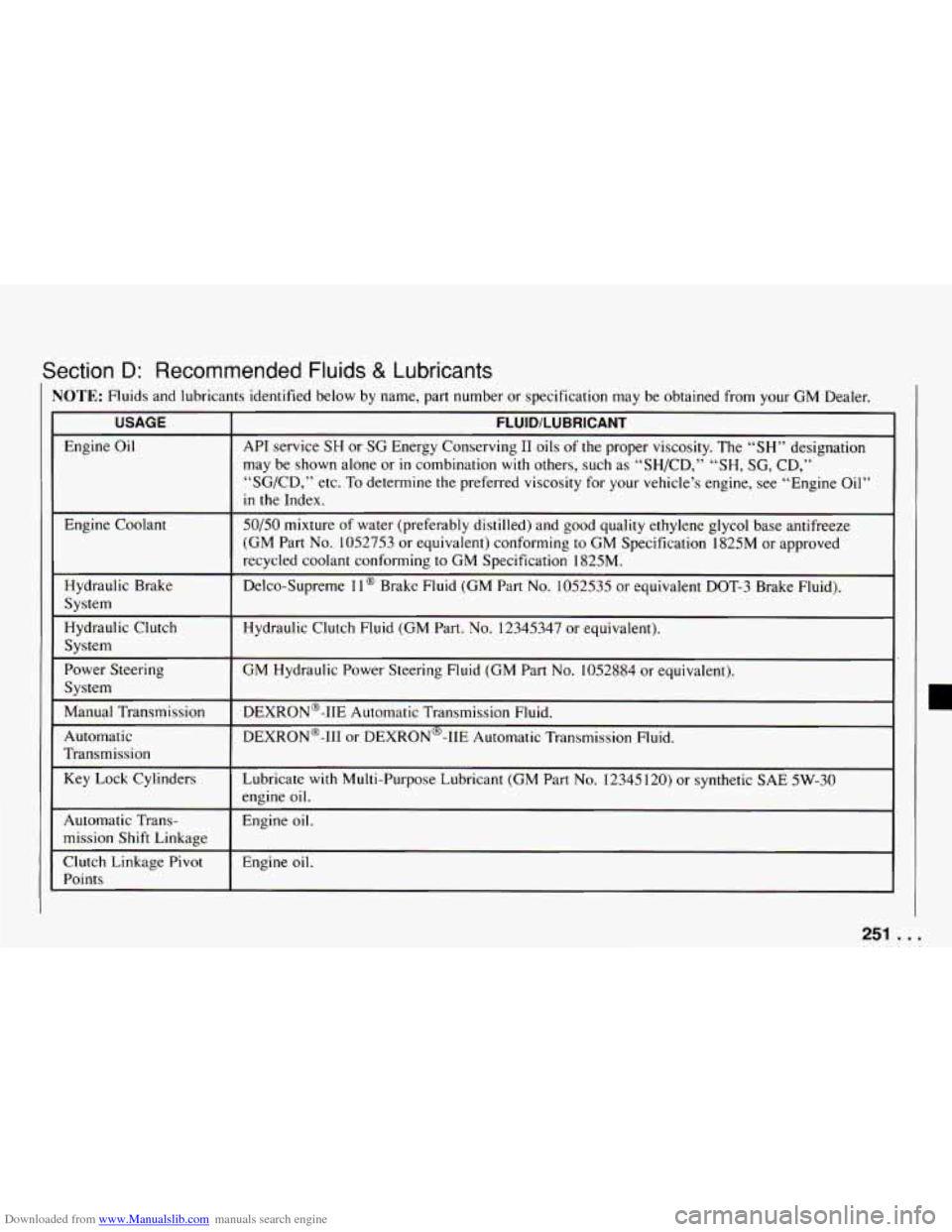
Downloaded from www.Manualslib.com manuals search engine Section D: Recommended Fluids & Lubricants
I NOTE: Fluids and lubricants identified below by name, part number or specification may be obtained from your GM Dealer.
USAGE
Engine Oil
Engine Coolant
Hydraulic Brake
System
Hydraulic Clutch
System
Power Steering
System
Manual Transmission
Automatic
Transmission
Key Lock Cylinders
Automatic Trans-
mission Shift Linkage
Clutch Linkage Pivot
Points
FLUID/LUBRICANT
API service SH or SG Energy Conserving I1 oils of the proper viscosity. The “SH” designation
may be shown alone
or in combination with others, such as “SH/CD,” “SH, SG, CD,”
“SG/CD,” etc.
To determine the preferred viscosity for your vehicle’s engine, see “Engine Oil”
in the Index.
50/50 mixture of water (preferably distilled) and good quality ethylene glycol base antifreeze
(GM Part No. 1052753 or equivalent) conforming to GM Specification 1825M or approved
recycled coolant conforming to GM Specification 1825M.
Delco-Supreme
11 @ Brake Fluid (GM Part No. 1052535 or equivalent DOT-3 Brake Fluid).
Hydraulic Clutch Fluid (GM Part.
No. 12345347 or equivalent).
- ~- -~~ --
~ M Hydraulic Power Steering Fluid (GM Part No. 1052884 or equivalent).
DEXRON@-IIE Automatic Transmission Fluid.
DEXRON@-111 or DEXRON@-IIE Automatic Transmission Fluid.
Lubricate with Multi-Purpose Lubricant (GM Part No. 12345
120) or synthetic SAE 5W-30
engine oil.
Engine oil.
Engine
oil.
251 . . .